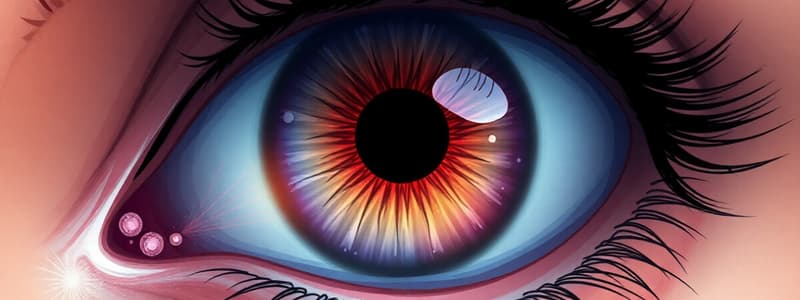Podcast
Questions and Answers
Qual es un symptom caracteristic del Aqueous deficiency dry eye (ADDE)?
Qual es un symptom caracteristic del Aqueous deficiency dry eye (ADDE)?
- Fluctuation de vision (correct)
- Irritation de retina
- Sensatio de pressura intraocular
- Elevatio del lacrimale secretion
Quales son indicios de Aqueous deficiency dry eye (ADDE)?
Quales son indicios de Aqueous deficiency dry eye (ADDE)?
- Oedema de congiunctiva
- Infection bacteriana
- Filamentos (correct)
- Exudato purulente
Qual es un caracteristica de Sjogren's syndrome primari?
Qual es un caracteristica de Sjogren's syndrome primari?
- Absente de xerostomia
- Risico aumentate de lymphoma (correct)
- Aumento del production lacrimale
- Debilitate musculare
In quale conditiones si observa le secondari Sjogren's syndrome?
In quale conditiones si observa le secondari Sjogren's syndrome?
Quales lab tests es relevante in le investigation de Sjogren's syndrome?
Quales lab tests es relevante in le investigation de Sjogren's syndrome?
Qual es le causa principal de K sicca?
Qual es le causa principal de K sicca?
Qual es le normalitate del test de Schirmer sin anesthesia?
Qual es le normalitate del test de Schirmer sin anesthesia?
Le tear film osmolarity es considerate abnormal quando supera cual valore?
Le tear film osmolarity es considerate abnormal quando supera cual valore?
Qual es un tratamento populare per il K sicca asociate con le Sindrome de Sjogren?
Qual es un tratamento populare per il K sicca asociate con le Sindrome de Sjogren?
Qual opzione non esun forma de modification ambientale pro le gestione de K sicca?
Qual opzione non esun forma de modification ambientale pro le gestione de K sicca?
Flashcards
Syndrome de Sjogren
Syndrome de Sjogren
Un syndrome auto-immune qui affecte principalement les glandes salivaires et les glandes lacrymales, causant la sécheresse des yeux et de la bouche.
Déficit aqueux de l'œil sec (ADDE)
Déficit aqueux de l'œil sec (ADDE)
Un type de sécheresse des yeux causée par une production insuffisante de larmes en raison d'une inflammation des glandes lacrymales.
Syndrome de Sjogren primaire
Syndrome de Sjogren primaire
Une forme de syndrome de Sjogren qui n'est pas associée à d'autres maladies auto-immunes.
Syndrome de Sjogren secondaire
Syndrome de Sjogren secondaire
Signup and view all the flashcards
Biopsie de la glande salivaire
Biopsie de la glande salivaire
Signup and view all the flashcards
Keratoconjunctivitis sicca (K sicca)
Keratoconjunctivitis sicca (K sicca)
Signup and view all the flashcards
Test de Schirmer
Test de Schirmer
Signup and view all the flashcards
Agentes Cholinergic Oral
Agentes Cholinergic Oral
Signup and view all the flashcards
Keratitis Filamentar
Keratitis Filamentar
Signup and view all the flashcards
Plugs Punctal
Plugs Punctal
Signup and view all the flashcards
Study Notes
Non-Cicatricial Ocular Surface Disorders
- This presentation covers non-scarring eye surface issues, specifically Sjogren's Syndrome.
Sjogren's Syndrome
- Aqueous Deficiency Dry Eye (ADDE): Characterized by insufficient tear production.
- T cell-mediated inflammation: Immune cells trigger inflammation in the tear-producing glands.
- Decreased tear production: Reduced tear generation.
- Two Major Classes: Primary and secondary Sjögren's syndrome.
- Symptoms: Dry eye, worsening later in the day.
Symptoms of ADDE
- Blurred Vision: Fluctuating vision.
- Grittiness/Foreign Body Sensation: Burning and itching sensations.
- Pain (especially filamentary keratitis): Significant pain.
- Photophobia: Sensitivity to light.
- Mucus/Sticky Discharge: Viscous secretions.
Signs of ADDE
- Bulbar Conjunctival Injection: Inflammation of the white part of the eye.
- Decreased Tear Meniscus: Reduced tear layer.
- Debris/Mucus in Tear Film: Presence of foreign matter in the tears.
- Punctate Epithelial Erosions: Small breaks in the protective surface layer.
- Filaments: Thread-like structures in the eye.
- Irregular Astigmatism: Uneven eye shape.
Primary Sjogren's Syndrome
- Increased Risk of Lymphoma: Higher chance of developing lymphoma.
- Dry Mouth (Xerostomia): Mouth dryness.
- Dry Eye: Insufficient tear production.
- Vaginal Dryness (sometimes): Additional symptom in females.
- Associated Conditions: Fibromyalgia, Polyarthralgia, Depression, and Anxiety.
Sjogren Investigation: Biopsy
- Salivary Gland Biopsy: Tissue sample from salivary glands to examine.
- Lower Lip Biopsy: (minor salivary glands) for inspection.
- Lymphocytic Infiltration: Presence of immune cells within tissue.
Secondary Sjogren's Syndrome
- Association with Other Conditions: Often associated with Rheumatoid arthritis, Systemic Lupus Erythematosus (SLE), Progressive Systemic Sclerosis, Polymyositis & Dermatomyositis and Mixed Connective Tissue Disease.
Sjogren Investigation: Labs
- Antibodies: Presence of antibodies, such as anti-Ro/SS-A, anti-La/SS-B, and Rheumatoid Factor.
- Anatomic Nuclear Antibody (ANA): Blood test for autoantibodies.
- Erythrocyte Sedimentation Rate (ESR): Lab test indicating inflammation.
- C-Reactive Protein (CRP): Marker of inflammation.
Ocular Surface Staining
- Bulbar Conjunctival Staining (especially temporal): Dye to reveal spots on the eye suggestive of damage on the eye surface.
- Patchy Pattern K Staining: Non-specific for Sjogren's Syndrome.
- Keratoconjunctivitis Sicca (K. Sicca): Dry eye condition.
Keratoconjunctivitis (K) Sicca vs Dry Eye
- Keratoconjunctivitis Sicca (K. Sicca): Irregular eye staining pattern, from insufficient or unusual tear formation or quality.
- Dry Eye: Overall deficiency in tear production or tear quality.
- Decreased Tear Production: Lower quantity of tears, which is a part of keratoconjunctivitis sicca.
- Increased Tear Evaporation: Tear loss potentially due to increased evaporation rate.
- Tear Film abnormalities: Potentially due to abnormal composition of tears.
Clinical Assessment
- Procedure to evaluate eye health.
Ocular Surface Disease Index (OSDI)
- Diagnostic tools to quantify symptoms associated with dry eyes.
- Scoring system to evaluate the severity of symptoms.
Schirmer's Test
- Measures tear production, with or without anesthetic.
- Normal Results: Tear production exceeding a certain measurement (mm).
- Abnormal Results: Tear production below this measurement.
Tear Film Osmolarity
- Measures the salt concentration of the tear film.
- Normal Tear (Healthy): Low salt concentration.
- Hyperosmolarity (Dry Eye): High salt concentration, suggesting abnormally high tear concentrations, which dries the eye.
Ocular Treatment
- PFAT's (Platelet-Rich Fibrin-Autologous Tissue):
- Autologous Serum or Octaplas:
- Platelet-Rich Plasma (PRP):
- Topical Steroids:
- Topical Cyclosporine: Eye drops or ointments.
- Restasis: (eye drops)
- Cequa: (eye drops)
- Erythromycin:
- Vitamin A:
- Ointments: For topical application.
- Punctal Plugs: (Medical Procedure) Block tear drainage in the eyes.
Punctal Plugs
- Intra/Canicular Location: Placement of the plug in a specific eye area.
- Dissolvable vs Semi-Permanent: Different durations of plug effects.
Environmental Modification
- Hydration: Drink enough water.
- Humidifiers: Increase moisture and humidity in your surroundings.
- Moisture Chamber Goggles: Protects eyes from air and environmental conditions.
- Sleep Goggles: Prevent eye dryness during sleep.
- Conscious Blinking: Use blinking strategically when using digital devices.
Sjogren's Syndrome Management
- Multidisciplinary Team: Collaboration of specialists (Rheumatologist, Ophthalmologist, and Dentist)
- Oral Cholinergic Agonists: Drugs to stimulate saliva and tear production.
- Pilocarpine: Drug to stimulate saliva and tear production (oral)
- Cevimeline: Drug to stimulate saliva and tear production (oral).
Filamentary Keratitis
- Symptoms: Thread-like mucus strands in the eye, significant eye pain.
- Treatment: Removal of mucus, anti-inflammatory eye drops (possibly containing corticosteroids) and eye drops containing anti-inflammatories or other medications.
Perforation Assessment
- Seidel Test: Used to check for fluid leakage from the anterior chamber of the eye.
Desmetocele
- Description: A specific eye condition related to a problem in the protective layer of the eye.
Thygeson Superficial Punctate Keratitis
- Symptoms: Itching, tearing, foreign body sensation in the eye, slight eye pain or discomfort, and visual discomfort associated with irritation.
- Characteristics: Raised lesions on the surface of the eye, negative surface staining.
- Treatment: Medicated eye drops.
Studying That Suits You
Use AI to generate personalized quizzes and flashcards to suit your learning preferences.
Related Documents
Description
Este quiz explora los disordines ocular non-cicatricial, con un foco special al Sindrome de Sjogren. Examina los sintomas e signos asociados con la insufficiencia de produccion de lagrimas e inflammation. Testa tu conocimiento sobre estas condiciones oculars e sus implicaciones.




